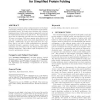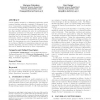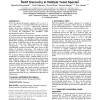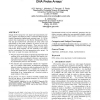97
Voted
RECOMB
2003
Springer
16 years 1 months ago
2003
Springer
We describe a novel method for detecting the domain structure of a protein from sequence information alone. The method is based on analyzing multiple sequence alignments that are ...
87
Voted
RECOMB
2003
Springer
16 years 1 months ago
2003
Springer
In this paper, we describe a method for statistical reconstruction of haplotypes from a set of aligned SNP fragments. We consider the case of a pair of homologous human chromosome...
76
Voted
RECOMB
2003
Springer
16 years 1 months ago
2003
Springer
112
click to vote
RECOMB
2003
Springer
16 years 1 months ago
2003
Springer
Recent research has demonstrated quite convincingly that accurate cancer diagnosis can be achieved by constructing classifiers that are designed to compare the gene expression pro...
94
Voted
RECOMB
2003
Springer
16 years 1 months ago
2003
Springer
Many genomic sequences and, more generally, (multivariate) time series display tremendous variability. However, often it is reasonable to assume that the sequence is actually gene...
93
Voted
RECOMB
2003
Springer
16 years 1 months ago
2003
Springer
Critical to the understanding of the genetic basis for complex diseases is the modeling of human variation. Most of this variation can be characterized by single nucleotide polymo...
104
click to vote
RECOMB
2003
Springer
16 years 1 months ago
2003
Springer
Genetic linkage analysis is a challenging application which requires Bayesian networks consisting of thousands of vertices. Consequently, computing the likelihood of data, which i...
105
Voted
RECOMB
2003
Springer
16 years 1 months ago
2003
Springer
In [13] we reported the genome sequences of S. paradoxus, S. mikatae and S. bayanus and compared these three yeast species to their close relative, S. cerevisiae. Genome-wide comp...
90
Voted
RECOMB
2003
Springer
16 years 1 months ago
2003
Springer
114
click to vote
RECOMB
2003
Springer
16 years 1 months ago
2003
Springer
Protein sequence alignments are more reliable the shorter the evolutionary distance. Here, we align distantly related proteins using many closely spaced intermediate sequences as ...




